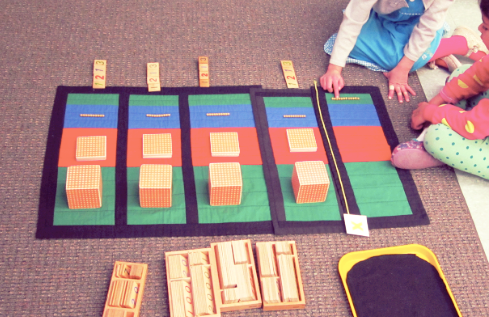
The Montessori materials share certain qualities: they are hands-on, beautiful and self-correcting. They isolate concepts to be explored and they allow children to understand independently whether they've done the work "correctly." Many of the materials also include implicit lessons, concepts that are consistently applied in the design of the lessons such that certain relationships are internalized for children before they're ever explicitly taught.
For example, the materials throughout the Sensorial area are presented in series of tens, in which each cylinder or cube or prism differs from its neighbor by a value of ten and in which there are ten of any of those pieces. The Pink Tower, for example, is a series of cubes from 1cm in width to 10cms in width, with each cube 1/10th smaller than its larger neighbor. This orderly internalization of the relationships of tens is an implicit foundation for the Base Ten system, the relationships of numbers in our most commonly used number system. Children learn that units can be counted up to 9, but that once you've counted the tenth of a series, you're working with a new kind of set. Think about it… whether you're counting units or tens or hundreds or thousands, you can only count 9 of those things before you have to bump up to the next kind. Nine units plus one equals one ten. Nine tens plus one ten equals one hundred, and so on.
Working with larger numbers, then, is far more manageable for young children in our classrooms. We know they are motivated to operate large numbers (just ask your child how many jelly beans he or she thinks are appropriate for dessert- you're likely to hear something like, "One majillion and eighteen.") The Golden Beads, then, allow children to combine their internalized understanding of the Base Ten system with materials that let them count very very high. The result is work with naturally motivating materials that supports their developing understanding of numeracy and mathematical operations.
Here, the children are multiplying with the Golden Beads. They've laid out four sets of the same quantity, 1213, and now are counting them out to find out how many they are together. Multiplication, after all, is just addition of the same quantity over a number of times. So, while these girls will end up with a very large product (4,852 to be exact), they will only have had to count to ten to be able to do so. 3 units + 3 units + 3 units = 9 units. One more equals ten, which will quickly be exchanged for a ten bar. The remaining two unit beads will become part of the product.
Children may do this work alone, but they often invite a friend or two to work together. The experience with the Golden Beads and earlier math materials needed often coincides with the developmental affinity for working with friends… just another way in which the Montessori materials meet the developmental needs of the whole child.
#Math #ForParents #ForTeachers #Curriculum #FirstPlane #Primary
